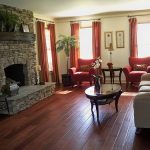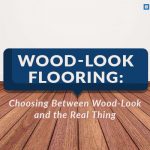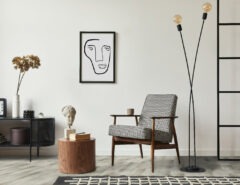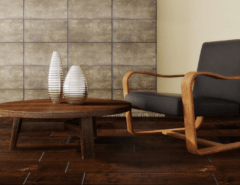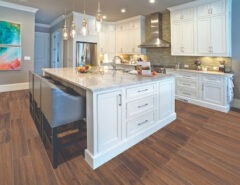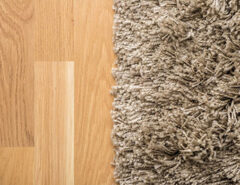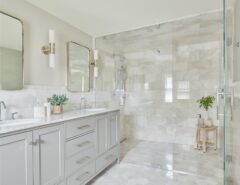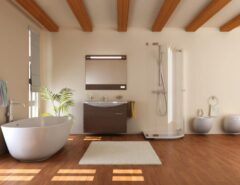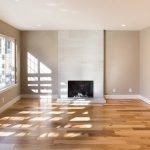 Today’s guest post is part 1 of 2 by Roger of FloorElf.com, a tile expert if there ever was one. He’s taken on a big topic for us, and for you; he answers the question of where design trends are going for tile in the upcoming year, 2011.
Today’s guest post is part 1 of 2 by Roger of FloorElf.com, a tile expert if there ever was one. He’s taken on a big topic for us, and for you; he answers the question of where design trends are going for tile in the upcoming year, 2011.
In this first segment, Roger gives some background on the trajectory of tile trends through the 20th century to today, which puts where tile trends for 2011 are going into helpful perspective…
***
With the new year just around the corner it’s time to step back and take a look at where design trends are headed with tile. While not necessarily a topic that changes right when the new year hits, understanding the direction in which design preferences are going helps you plan an installation which will last and not be out of style in 24 months.
To understand where to go from here it is always best to look at past style trends over a significant amount of time. Looking at a wide span of time will give you a solid foundation of what works and what people keep coming back to. So let us begin there.
Rooted in the past
Toward the turn of the century (last century – 1900, not this century…) when ceramic tile began being used as a common material for bathroom surfaces, the choices were fairly limited. The preferred and most readily available color for consumers was white. The reason is very simply that white was considered sterile or hygienic. A white ceramic bathroom looked ‘cleaner’ than one with a myriad of colors and materials.
As the century moved along, as centuries will, colors began making their way into the mix. The ‘colors’ at this time tended to be either black or very pale colors – more like pastels. I believe the pastels were mainly due to keeping with the lighter look rather than stark contrasts. The black being, around the 1920’s and 1930’s, the only real dark, contrasting choice available. There were dark red and dark blue available as well, but used less often, perhaps a matter of availability rather than choice.
1920s – 1940s
Hexagonal mosaics also became popular during the 1920′s and 1930′s in bungalow style homes. Some of these having black equivalents scattered throughout the pattern. These hexagonal mosaics in conjunction with bright white, ceramic wall tile was extremely common during this time period. The upper class houses may even contain a black ‘pencil’ trim through the wall tile to really offset the entire look and make it pop. That’s style right there!
1950s – 1960s
These same basic color designs were the mainstay up until about the middle of the 20th century. At the very end of the ’40s and really catching steam through the ’50s many of these sterile, white bathrooms moved toward a more ‘cool’ or relaxed style in the form of light, pastel shaded colors in bathrooms and kitchens. This is when the very light shades of yellow, green, and even pink became acceptable and normal. It may have been looked at as a way of standing out from the plain, boring white. Look, we’re uptown – we have a pink bathroom!
Toward the end of the 1950’s and into the beginning of the 1960’s is when ‘tract’ housing really, and I mean really, started becoming popular here in the States. Although popular from the 17th to 19th century in Inner-Europe, builders here figured out how much money they could save by building the same house over and over. Every house was either identical or a mirror-image. Yay conformity!
One key way people could distinguish their home from their neighbor’s was with different colors, and even shades, of tile in the bathrooms and kitchen. Yeah, Nancy over there has the pale pink tile but have you seen my dark yellow bathtub with matching tile? With white speckles??? I’m the queen of the neighborhood!
Around the mid-1960’s the choices of tile colors and patterns exploded. With every homeowner desiring a look which would differentiate their home from everyone else’s, the demand for something different became ever-present, and has continued to this day. The variations in colors, shades and patterns from the basic white or pastel colored tile remained up through the (gulp!) 1970’s.
1970s – 1980s
Aaaahhh, the 1970s.While comfortable in our recliners staring at an unbelievably powerful laptop computer with more power than it took to put a man on the Moon, it is very easy to look back at some of the decorating choices of that time as, well, completely insane. It’s difficult not to wonder if every homeowner in the ’70s was, indeed, color-blind. But at that time it was the ‘in’ thing, it was a sign of ‘making it’. Really. I’m not making that up. Yes, even the lime green.
Then the 1980s showed up. Black. Just black. Well, that’s not completely accurate, sometimes we would have an ‘offset’ colored tile in dark forest green. When I say dark I mean you could only see the ‘green’ aspect if you shined a spotlight on it. Black was it, man. Go dark – that’s different. The more dark tile you had in your house the more money you had in the bank. Dark wins. That mindset lasted about ten minutes.
Okay, maybe a bit more than ten minutes. The number of houses built during this time period of temporary insanity, however, saw the construction of a LOT of homes and, in turn, a lot of dark bathrooms. I am a child of the ’70s and ’80s. For everyone from my generation I’d like to apologize for that. I don’t know what we were thinking. I don’t know that we were thinking. But I do believe it was necessary to have that period because as the 1990’s rolled around a very curious thing began to happen, trends started moving back toward lighter colored tiles.

1990s – 2010
As the 1990s moved along not only did the colors begin trending toward the lighter end of the spectrum, textures began to play into the design choices. With the product availability spanning out into different materials like natural stone and glass tiles the possibilities became nearly endless and it was extremely easy to differentiate your home from anyone else’s. The norm switched from being different to being comfortable.
Warm beige tones along with natural textures have been very common for about the last fifteen years. Travertines, tumbled stone and muted shades of polished stone coupled with offsetting inserts and listelles were incorporated to give spaces a warm and inviting feel.
Along with these gradual steps back toward lighter colors and more textures designs began incorporating larger format tiles. This really started in the 1980s, but the overbearing look of the dark tones all but negated the size aspect of designs – it simply went unnoticed. As the tile colors lightened, however, the larger size of the tile became a key part of the designs.
***
Thanks, Roger!
Stay tuned for part 2 next week, when we take what the past decades have taught us to help us see into the future of tile, 2011!
In the meantime, for more tile-centric pearls of wisdom, you should consider following Roger @FloorElf on Twitter.
Cheers,
Rob.



